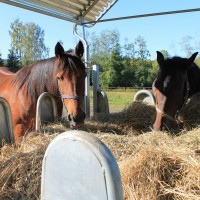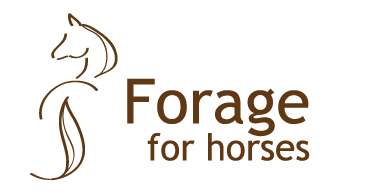Forage and horses’ mineral requirements

Minerals are divided into major minerals and trace elements, and calcium (Ca), phosphorus (P), magnesium (Mg), sodium (Na) and potassium (K) belongs to the major minerals. Iron (Fe), cupper (Cu), manganese (Mn), zinc (Zn), cobalt (Co), iodine (I) and selenium (Se) belongs to the trace elements. The major minerals Ca and P are among other things main components in the horse’s skeleton. The major mineral Mg participates in muscle contractions and is a cofactor in several enzyme systems. Several minerals co-operate with each other and can also disturb the absorption of other minerals and there is a maximum tolerance intake. Over-feeding with minerals should be avoided but recommended amounts can be exceeded if the forage has high content without negative effects on the horse. Recommended mineral intakes should not fall below during longer periods.
In a Swedish study forage samples were collected from 124 farms in Sweden and Norway which were analyzed for Ca, P, Mg, K, Na, Co, Cu, I, Fe, Mn, Se and Zn content. Information regarding the farms’ forage production such as fertilizing, botanical composition, harvest date etc. was documented.
The mineral content of the analyzed feed samples was compared with horses’ mineral requirements and the results showed that the forage samples had adequate amounts of Mg, K, Fe and Mn for all classes of horses. Most of the samples did not contain adequate amounts of Na, Co, Cu, I, Se and Zn to cover the requirements of any horse category. Contents of Ca and P were adequate for covering the maintenance requirements but were close to deficient for heavily exercising, gestating, lactating and growing horses. Therefore it is suggested that a suitable mineral feed containing Ca, P, Na, Co, Cu, I, Se and Zn should complement horses’ diets.
Harvest number, botanical stage of maturity at harvest, wilting time and botanical composition affected the forages’ mineral content. The results show that forage from regrowth imply higher concentration of several minerals while longer wilting time imply lower concentrations. Later botanical stage of maturity at harvest imply higher NDF content and lower mineral content. Forage with legume inclusion, for example clover, has higher content of Ca.
In conclusion it is important that forage for horses also is analyzed for mineral content and the feed ration complemented with suitable mineral feed. To calculate requirements and work out a suitable feed ration is additionally important for heavily exercising, gestating, lactating and growing horses.
Sara Muhonen, AgrD
References:
Jansson A, Lindberg JE, Rundgren M, Müller C, Connysson M, Kjellberg L & Lundberg M. 2011. Utfodringsrekommendationer för häst. Inst. för Husdjurens Utfodring och Vård, SLU. (In Swedish)
